According to Forbes, the occupancy rate among US multi-family housing units rose to 96.9 percent in mid-2021, and the trend has continued post-pandemic. With real-estate prices increasing sharply and rent costs reaching all-time highs, there’s more incentive than ever to renovate, update and repurpose commercial and light commercial facilities, whether properties include multi-tenant housing, mixed Read more
Featured Articles

According to Forbes, the occupancy rate among US multi-family housing units rose to 96.9 percent in mid-2021, and the trend has continued post-pandemic.
With real-estate prices increasing sharply and rent costs reaching all-time highs, there’s more incentive than ever to renovate, update and repurpose commercial and light commercial facilities, whether properties include multi-tenant housing, mixed office space, retail locations, etc.
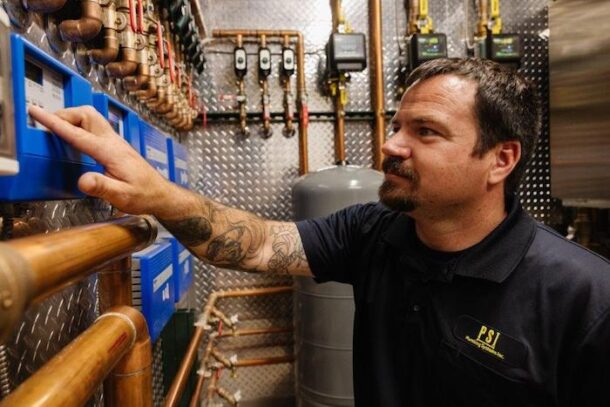
Brandon Content, at Plumbing Systems Inc., establishes a connection between several boilers and the tekmar control system that serves the large vacation home.
Compared to new construction, however, this leaves property owners, managers and mechanical contractors at a disadvantage: older but serviceable mechanical equipment can be difficult to integrate with a smart and connected control platform.
This may be especially true in northern climates, where hydronic systems have been the default source of space heat due to boiler efficiency, comfort, longevity and the ability to provide ample domestic hot water.

Staging and remotely monitoring boiler plants without a BAS installed has become easier than ever with next-generation control modules.
Older boiler plants generally lack connectivity in the 50,000-square-foot and under market, where installing a building automation system (BAS) may not be worth the expense.
James Dice, PE, CEM, CMVP, founder of Nexus Labs, recently wrote a white paper titled “The Untapped 87%: Simplifying Controls Technology for Small Buildings.” In it, the author explains that a 20,500 square foot building was retrofitted with a BAS by the United States Department of Energy’s Pacific Northwest Laboratory (PNNL) in 2010. Within the first two years, this lead to a 22% energy savings, 25% return on investment and a “dramatic decline” in occupant comfort complaints.
The white paper goes on to explain that buildings smaller than 50,000 square feet represent 94% of commercial buildings in the US, 44% of electricity use, and 44% of total energy use. Yet, only 13% of these buildings are equipped with a BAS.

High-end vacation homes benefit from remote boiler system access, as well as most commercial systems.
The reason? BAS systems are either too complex or not cost effective enough for the average building owner. BAS frequently cost $50k to $100k, which exceeds the fiscal budgets of many building owners. In addition, they require an expensive annual service plan.
Because of this, there is massive opportunity to reduce energy consumption and simplify maintenance with the use of new, connected HVAC system controls without installing a BAS.
Aging boiler plants
Many commercial boiler plants feature multiple boilers for staged input or redundancy. Over the years, as various boilers were replaced, it’s not uncommon to have multiple different boiler models serving the same system.
For example, a system that was originally served by three conventional boilers of the same model might have been retrofitted with a single condensing boiler to replace two of the originals, while the third existing boiler remained in place for supplemental heat on design days.
In new construction applications or in systems where every boiler in the system is replaced, the boiler manufacturer’s onboard cascading controls are often used for lead-lag cycling of the units, though establishing remote access can still be a frustration.
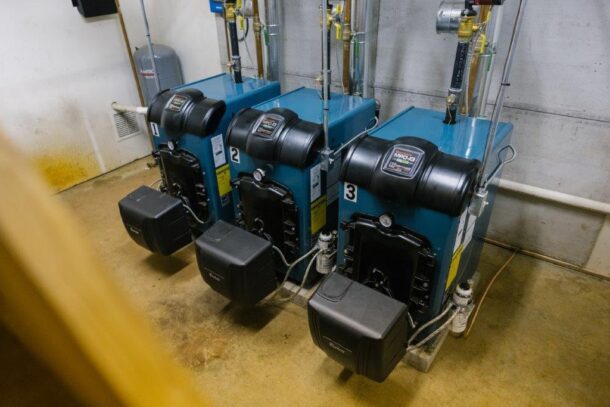
Three oil-fired boilers now serve a hydro-air system at a recreation building, using smart boiler controls to control all three units and provide remote access.
Fleet management is a major problem for facility managers. The heating system equipment is usually different in every building. This is due to the buildings being built and updated at different times, and buildings being acquired and sold by the management company.
So facility managers, property owners and mechanical contractors involved with light commercial systems too small to warrant the installation of a BAS are left asking how to control and remotely monitor their systems. If multiple properties are involved, the challenge is multiplied.
Evolving needs
“We’ve been building multi-stage boiler controls for over 30 years,” said Jay Vath, life cycle engineer at tekmar Control Systems. “There are a number of other control manufacturers with similar products, and for everyone in this market sector, the initial goal was to provide outdoor temperature reset for boilers that didn’t offer it.”
The demand for features in a boiler control package evolved along with the boilers themselves, along with the need for greater efficiency and control. Boiler manufacturers began offering outdoor reset and onboard staging across multiple, identical units. So the focus shifted to remote access, existing boiler plants, and the installation of hybrid condensing and non-condensing boilers plants.
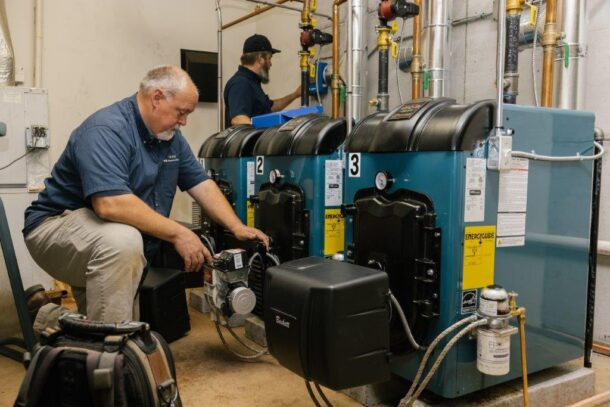
Firing a multi-boiler system
Control manufacturers introduced modules that offered some degree of remote monitoring capability for boiler plants, but one large issue remained: Many existing boiler plants included disparate models, often with decades separating them. There was no way to aggregate different brands and models onto a single, web-enabled control platform short of installing a BAS.
Long-sought solution
The primary drawbacks to installing a BAS solely for boiler plant control in a facility that otherwise doesn’t need it are the initial and maintenance cost, but equally important is the level of responsiveness on the part of the controls contractor. A BAS system creates an additional hurdle between the system and the service contractor. If an alert is generated by the boiler plant, the controls contractor – who may or may not be responsive in a reasonable amount of time – notifies the service contractor.
Eliminating the controls contractor and creating a direct conduit from the boiler plant to the service contractor reduces expense and expedites the service response.

A service tech uses the boiler control to check system operation.
“This is a key consideration for any connected boiler control,” said Vath. “It puts power in the hands of the service contractor, while providing remote monitoring capability for systems that may feature a number of different boiler makes models.”
Tekmar’s Smart Boiler Control 294 is an internet connected control that can be accessed via any web-enabled device for remote boiler plant monitoring and control. A boiler wizard provides integration with thousands of boiler models, and various levels of control and permission can be set for specific individuals, such as the service contractor, a facility manager and the building owner.
Compound savings
“Installing a smart and connected boiler plant control system provides real potential to save money on energy and maintenance,” said Vath. “Compared to a fixed operating setpoint system, outdoor reset alone can save upwards of 30 percent in fuel expenses.”
But there are many other savings advantages, some not as easy to quantify. Automatic boiler and pump shutoff reduces energy use when the system isn’t needed. Short-cycling is reduced or eliminated. Rotating boilers balances runtime hours, providing maintenance and longevity advantages. Staging boilers correctly helps accurately match the heating input to the load. Conventional and condensing boilers in the same plant can be grouped together and staged independently, keeping the least efficient appliance offline until needed. Some savings though, take place outside the mechanical room.
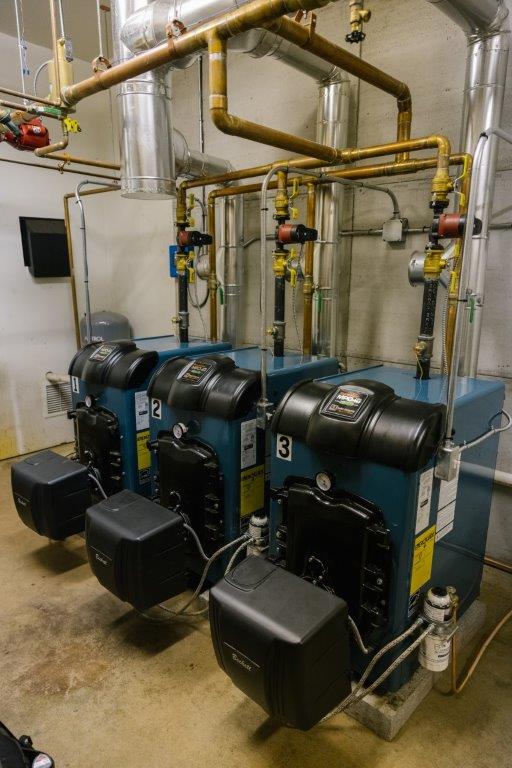 “With the notifications and insight that web-enabled boiler controls provide, the service technician knows what’s needed in the event of an alert, which they receive via email, text or push notification,” said Vath. “For example, a pressure input could indicate that the expansion tank’s diaphragm is flooded, so the technician would know in advance to put a replacement in the truck. With remote monitoring, dispatching occurs quickly. Alternatively, if the control generates an alert on an issue that can wait until the next scheduled service interval, an unnecessary trip is eliminated. This kind of information reduces unnecessary expense and allows service professionals to be proactive. The Watts OnSite app provides notifications when boilers and pumps are due for servicing based on run time hours. This allows for the creation of scheduled maintenance plans.”
“With the notifications and insight that web-enabled boiler controls provide, the service technician knows what’s needed in the event of an alert, which they receive via email, text or push notification,” said Vath. “For example, a pressure input could indicate that the expansion tank’s diaphragm is flooded, so the technician would know in advance to put a replacement in the truck. With remote monitoring, dispatching occurs quickly. Alternatively, if the control generates an alert on an issue that can wait until the next scheduled service interval, an unnecessary trip is eliminated. This kind of information reduces unnecessary expense and allows service professionals to be proactive. The Watts OnSite app provides notifications when boilers and pumps are due for servicing based on run time hours. This allows for the creation of scheduled maintenance plans.”
Using a flexible boiler plant control also offers cost saving options in the event of a retrofit. If the ability to connect an old boiler to a new control system is the only factor prohibiting a facility from leaving existing capacity online while retrofitting a portion of the mechanical system, that’s no longer a concern. New boilers can be paired with old boilers for backup heat, ultimately reducing the amount of new firing capacity needed.
Forward-backward compatibility
“For systems that already include tekmar boiler controls, updating the system with the 294 is simple,” said Vath. “All the equipment applications we’ve had in the past are covered by the 294.”
Similarly, the 294 can be quickly updated as new apps or other improvements are introduced. Updates and new features are sent to existing units as they’re developed. This is a big advantage for code compliance.
“In the future, if certain codes are accepted that require specific monitoring parameters, the 294 is designed to be updated to provide reporting as required.”
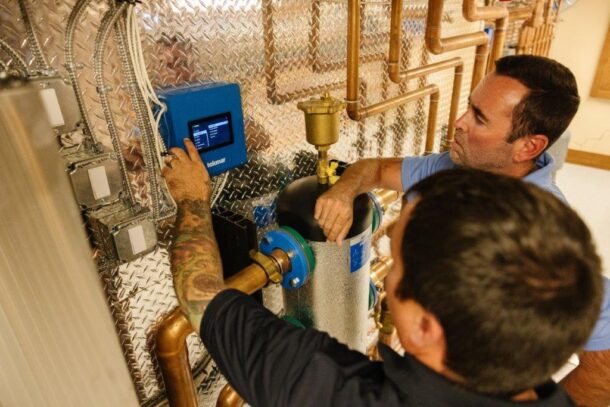
New hydronic system control packages are changing the way large residential and light commercial boiler plants are monitored and maintained.
This flexibility allows the owner to remain current, not just to become current now. It’s a matter of being proactive, not reactive.
For example, 30 U.S. municipalities across the US are currently phasing in higher standards for commercial real estate emission reductions and energy consumption. A long-known problem is that systems become less efficient over time due to poor maintenance. Remote monitoring is a key method to keep the boiler system operating at the designed efficiency.
Customized control
Web-enabled boiler controls offer a “BAS Lite” solution. With that comes substantial customization.
“The fact that dissimilar boiler technology is being controlled by a single system, tailored to the needs of an individual customer and property means that the control platform has to be extremely versatile,” said Vath. “For that reason, the 294 can be configured for many combinations.”

Staging and remotely monitoring boiler plants without a BAS installed has become easier than ever with next-generation control modules.
For example, a fixed “lead” boiler can be established, in the event that a draft is needed for one of the boilers in the system. A fixed “last” can also be established in the event that a conventional boiler is used only under design conditions, allowing condensing units to fire first.
Control can be established for firing rates or water temperatures, and the system can switch between the two depending on the call for heat. A DHW call may create a water temperature setpoint while a call for space heat may dictate boiler firing rate, and so on.
Security and ownership
Much of the remote access in buildings from the past 20 or 30 years was closed-loop, like key card room access, fire alarms, auto-dialers, etc. To provide full-featured remote access to a variety of team members, an internet connection is needed for a cloud-based platform.
“Fundamentally, where we’ve changed gears from what was done in the past is connectivity,” said Vath. “Once the 294 is connected via Wi-Fi or Ethernet, we use the Watts Onsite app or browser interface to remotely access the device with the ability to adjust every setting in the control. This has a great deal of value for property management groups that have a fleet of buildings, seeking control consistency across properties and boiler plants.”
Security is built into the control and into the Microsoft Azure platform that it operates on. Access is end-to-end encrypted, just like a banking app. Login information is specific to each individual on the team and does not need to be shared among members. The physical control also includes a passcode to prevent unauthorized access.
The program and information resident on the physical controller is a digital twin of the control on the remote device. The virtual device can be modified in real-time, immediately updating the physical device. This reduces trips to the property and allows every member of the team to access the system. Team members who have access to the digital twin can be added and removed, and different levels of access can be established for each.
The new control offers as many advantages to the owner as it does to the service professional. Ownership can be transferred in the event of property sale. Transfer of responsibility is quick and simple, if the service contract changes hands.
The property owner can also monitor and review the responsiveness of the contractor. An acknowledgement is logged when the service professional reviews the alarm. This allows the owner to see if they’re receiving the service they’re paying for.
Ultimate flexibility
Creating remote access for existing light commercial boiler plants requires a great deal of flexibility. Varying loads, miss-matched boiler models and different building codes to conform to all require a control package to be extremely flexible. Looking ahead, the potential addition of air-to-water heat pumps is something that a modern boiler plant control system has to be able to facilitate.
“The only constant is change,” said Vath. “Building owners change, technology changes, service contracts change, codes change. A modern boiler control package must adapt to these transitions.”
This piece was contributed by Eric Balt, technical sales manager for tekmar Control Systems and Mercedeh Fallahkhair, senior product manager for tekmar Control Systems
References:
Dice, J. “The Untapped 87%: Simplifying Controls Technology for Small Buildings”, Accessed June 2023
Cole, R. (2021, November 8). These are the Multifamily Trends Experts Are Predicting for 2022. Forbes.https://www.forbes.com/sites/reginacole/2021/11/08/multifamily-trends-in-2022/?sh=523a0e4b82bb Accessed June 2023
Sadovi, M. W. (2022, November 29). Five US cities target building energy use, emissions with fines. CFO Dive. https://www.cfodive.com/news/five-us-cities-target-building-energy-use-emissions-fines/637538/, Accessed June 2023

Publisher Note: This article was originally on ConstructioNext. Article-A Blueprint for Preventing Suicides in Construction Author: Sharon O’Malley Construction workers die by suicide at four times the rate of the general population, and the industry consistently ranks No. 1 or No. 2 in deaths by suicide among all occupations. Here is a comprehensive guide for Read more
Publisher Note: This article was originally on ConstructioNext.
Article-A Blueprint for Preventing Suicides in Construction

Author: Sharon O’Malley
Construction workers die by suicide at four times the rate of the general population, and the industry consistently ranks No. 1 or No. 2 in deaths by suicide among all occupations.
Here is a comprehensive guide for construction companies to employ to save lives.
None of the men died on the job, but the suicides left the commercial roofing company’s president and co-owner, Christee Holbrook, hyperaware that in the construction industry, “If you stay in business long enough, it will happen to you.”
In fact, men working in construction die by suicide at four times the rate of the general population, and since the Centers for Disease Control and Prevention started comparing suicide rates by industry in 2016, construction has consistently ranked No. 1 or No. 2.

More construction workers die by suicide each year than by falls or electrocutions, or being struck by or caught in objects on the worksite—the Occupational Health and Safety Administration’s “focus four”—combined.
Yet when one of Holbrook’s suicidal employees “started showing signs of mental illness and started just falling apart before our eyes … we didn’t know what it was at the time,” she said. “I thought he was just going through a divorce.”
Although suicide is not a new problem for the construction industry, mental health and safety experts have noted that the field is dominated by male employees, who traditionally have been reluctant to talk about mental health and other problems that can lead to suicide.
With approximately 5,000 suicides among construction workers reported every year, mental health professionals and some industry executives like Holbrook have begun to embrace the notion that workplaces need to be proactive in preventing mental-health-related deaths among their employees. To do that, those experts advise, construction firms should count suicide and mental health as workplace safety issues and make awareness and prevention as much a part of training and discussions as jobsite hazards like electrocutions and falls.
“We came to believe that the workplace is the most cross-cutting system for suicide,” said psychologist Sally Spencer-Thomas, a leader of Construction Working Minds, a group that focuses on suicide prevention, mental health awareness and addiction recovery. “Most (construction workers) are out of the education system and are not in the health-care system, but they’re working. That seems like the most important gap to fill.”
Cal Beyer, vice president of workforce risk and worker well-being for insurance brokerage Holmes Murphy, which counts construction as a specialty, has proposed a three-tier approach to filling that gap: “The companies that are addressing this are acknowledging there is a problem; taking time to understand it; then doing something about it.”
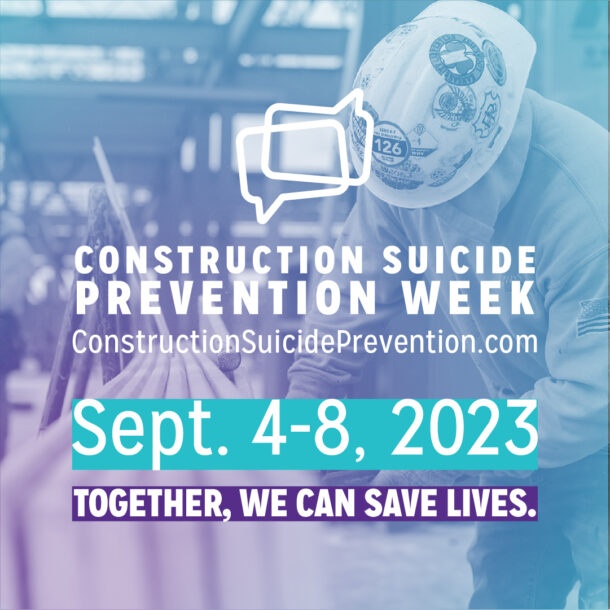
Industrywide, many trade associations, unions, construction firms, nonprofits, mental health providers and government agencies are offering training, materials and campaigns—like Construction Suicide Prevention Week from Sept. 4-8, when construction firms are asked to “stand down” for 15 to 20 minutes each day to talk about suicide prevention.
Like others involved in raising awareness about suicide prevention, Holbrook incorporates that message in toolbox talks year-round. She also occasionally interrupts the workday with offers of stress-reducing perks like on-site massages; actively advertises the mental health services that her company’s health insurance provider covers; and makes it her business to notice when an employee seems down or whose behavior has changed.
“I did a lot of crying” after the suicides among her employees, recalled Holbrook, who also is the safety committee chair for Associated Builders and Contractors Mississippi. “That was then. My goal (now) is to figure out what we can do to help going forward, how we can be prepared.”
While the media are quick to publicize the number of construction industry suicides when the government issues statistics pointing to the scope of the problem, much more is needed to quell the number of deaths each year. This report from ConstructioNext offers comprehensive information on mitigating suicide risk among construction workers, with the hope of saving lives.
Following are four detailed steps, along with resources and tips, that mental health professionals and construction industry leaders have identified as important in the effort to prevent suicides among construction employees.
Step 1. Acknowledge the problem
Spencer-Thomas, whose only brother died by suicide in 2004, said construction workers regularly tell her that their mental health issues and thoughts of suicide coincide with feelings of overwhelming stress.
“Construction is a very unique industry” that requires employees to work long shifts and sometimes to travel to jobsites where they may not have easy access to their regular doctors or the company of their family and friends, said Samantha Melchor-Frost of HealthSource Solutions in Columbus, Ohio. Melchor-Frost, an exercise physiologist and wellness program manager for a number of large construction firms, noted that contractors also regularly lose their income when a job wraps up or the seasons change. Plus, she said, their jobs are physically demanding and they suffer frequent injuries.

Those injuries can lead to alcohol use and the abuse of painkillers, added homebuilder Brandon Bryant, who recalled a trade partner who got into a skateboarding accident that landed him in the hospital one weekend. Still, he reported for work the next day—aided by painkillers, to which he became addicted. He eventually lost his job.
“Alcohol and drugs are still the elephant in the room,” noted Beyer, a former risk management director for a Washington-based paving contractor. A prevailing attitude on some jobsites, Beyer said, is, “I don’t care about what you do on your personal time as long as you show up for work.”
But he added that drug use leads to sleep deprivation and lack of focus, and pointed to National Safety Council data showing that 19% of construction workers are substance abusers compared with 8.5% of workers in other industries.
Beyer also pointed to the prevalence of bullying on jobsites.
“It’s such an issue in construction, where people are made fun of for making a mistake,” he said. “People are ridiculed when they join a crew; it’s an antiquated construction mentality.… There will always be a degree of that because of that tough-guy mentality, (but) it doesn’t get anyone anywhere.”
Still, jobsite concerns aren’t the only ones that drive employees to suicide. Holbrook recalled approaching a roofer who seemed depressed, only to learn that his mother had been murdered and he had found the body. She offered him time off and referred him to a counselor, and he eventually returned to work.

“We all know what jobsite hazards are, but we don’t talk about the psychosocial hazards that employers put upon their workers,” Spencer-Thomas said. Workers are “way more likely to die from the psychosocial causes, not slips and falls and ladders. Like divorce. Would divorce have happened if they hadn’t spent so much time away from a spouse?”
Beyer agreed. “It’s important to say this is a very complex issue,” he said. “There’s not one single cause. It’s a nexus or confluence of risk factors, industry and cultural factors, and some company and job factors where a person works. There are job task and environmental factors, lifestyle and worker choices. When we just say ‘the culture,’ we’re missing some of the possible other solutions.”
One overall cultural barrier to spreading awareness about suicide is the reluctance of construction workers to talk about personal issues at work, the experts said.
“It’s a tough-guy culture, that machismo culture where they don’t want to talk about concerns that they have because it’s not an industry that is open to that,” noted Karena Lorek, director of OSHA’s Kansas City area office.
Still, said Beyer, change is possible. “Get the company leaders together; let’s acknowledge there is a problem; let’s get leaders to do something about it, create an action plan, change our culture,” he said.
Step 2. Talk about it
Talking about suicide prevention does not result in more suicides, prevention experts agreed. Likewise, asking someone who threatens suicide to talk about why will not push the person over the edge.
“It’s not talking about it that’s hurting people,” Lorek said.
In fact, engaging someone in a discussion about personal problems often can ease the burden, said Sonya Bohmann, executive director of the Construction Industry Alliance for Suicide Prevention.

“In 80% of the cases, you can talk someone off of that crisis moment and get a commitment to safety and help them figure out how to get the resources they need,” Bohmann said. The first step in that scenario, she said, is to dial 988, the national suicide crisis line.
It’s a mistake for employers—or anyone—to do nothing when it’s clear an employee needs help, Bohmann said.
“Inactivity, not acknowledging when something has happened, creating a culture where people don’t feel comfortable having the conversation, sweeping things under the rug—these are mistakes to avoid,” she said.
Bohmann added that jobsite and safety supervisors “should be always talking about it. We should be starting that conversation. Don’t be afraid if you see someone’s change in personality. Never be afraid to ask somebody, ‘Are you OK?’ If they’re not, ask them: ‘Are you thinking of taking your own life? Are you making a plan?’ This helps destroy the stigma, and it creates an ally.”
Beyer said too many in the industry believe it’s not appropriate to talk about suicide at work.
“People (used to say), ‘Don’t go there, it’s a possible liability; don’t talk about mental health in the workplace,’” Beyer said.
But Bohmann disagreed: “If you get one person to open up, you’ve just saved a life.”
It can be difficult to get contractors, particularly men, who often pride themselves on being independent and self-sufficient, to talk about suicide, the experts said.
“The tough-mindedness … is really their superpower,” Spencer-Thomas said of contractors. “You can’t do this work unless you are tough and strong and stoic and decisive, a good problem solver, courageous, fearless. But like all superpowers, there’s an underbelly—our vulnerability that’s related to our strength. And the thing that they do … is the most likely to kill them.”
Holbrook said she eased her crew into these tough conversations “gently.”
“When I started doing it, they were looking at each other,” Holbrook said. “But now they’re used to it and most of them are pretty forthcoming. … The key is starting out slowly and introducing (the topic) and then keep on with consistency. They don’t look around at each other like we’re all crazy like they did when we started talking about it.”

Mandy McIntyre, of Level Up Consultants in Cleveland, noted that adding discussions of suicide prevention to toolbox talks is a nonthreatening way to get contractors to examine their feelings. “You’re not bringing everyone together for a ‘Kumbaya,’” said McIntyre, the former vice president of a Cleveland-based roofing company. “You’re getting everyone together for a safety topic.”
Spencer-Thomas encourages employers to recruit employees and guest speakers with lived experience to share their stories during staff meetings and toolbox talks.
That is how homebuilder Bryant started his company’s mental health initiative for employees and trade partners. At first, he struggled to get his staff of tough, independent construction workers to talk to him. “It’s hard to reach out to people and say, ‘Hey, anybody willing to talk about mental health?’” he said. “We needed some volunteers.”
Bryant became the first volunteer.
He didn’t plan to kill himself, Bryant told his crew. “I don’t remember exactly what went down in the moment,” he said, when he bundled “a year’s worth of pressure, of not being good enough, of not being able to provide,” and jumped in his pickup “on the verge of doing something stupid” during the housing crisis of the mid-2000s.
His guardian angel talked him out of it, Bryant recalled, and instead of gunning the accelerator, he drove to meet some friends and told them everything: about his struggling company; his wife’s decision to take a good job three states away; his newborn baby; the conflicts he was having with others; his bitterness and anger.
“I never felt more supported and loved,” he shared with his employees.
“It (was) hard reliving it,” Bryant said, but sharing his story prompted several others on his crew to open up about their own struggles.
“Two employees called me the next day and said, ‘Thank you for sharing. Here’s what’s going on with me. … If you’re struggling, I feel better about my struggle.’”
Bryant added: “I want to make this a place they can come and be who they are.”
The Cost of Saving a Life
Trade associations, unions and government agencies regularly fill orders for free posters or will send a speaker to talk at a construction company staff meeting about mental health or suicide prevention.
Some services, like mental health first-aid training, could cost upward of $2,000 per person, but those who are certified can then train others in a company at no charge.
Still, said Bryant, “I’ve never seen it as a cost.”
“Shutting down operations for a few hours a month for suicide-themed toolbox talks or staff meetings means a bit of lost production,” Bryant said, but he added, “It’s an investment in people. I never look at it as what the cost would be. My answer is: I don’t think there is one.”
The aftermath of an employee suicide, on the other hand, can be costly. The Centers for Disease Control and Prevention has estimated that suicide costs American businesses a collective $70 billion a year, mostly in medical costs, lost worker hours and insurance, and recruiting and in training replacement employees.
The company may have to shut down temporarily or allow workers to take liberal leave as they grieve; bring in counselors; and respond to inquiries from the media and the public.
A suicide often results in increased absenteeism, loss of focus among those who knew the deceased, more visits to mental health professionals, potential legal action, increased fighting among employees and higher drug and alcohol use, Beyer said.
In addition, construction firms can experience employee resignations, workers’ compensation claims, challenges when recruiting, dissatisfied customers, damage to the corporate reputation, missed deadlines and even lawsuits from victims’ families that claim the company did not act to prevent the death.
Bryant said preventing suicides helps a company avoid most of those costs. “If I can take (someone) off the job for two days” and offer help that prevents a suicide, Bryant said, “that’s an investment and that’s money in my pocket.”
Indeed, two Australian researchers estimated that for every dollar an employer invests in a suicide prevention effort, it will reap more than $1.50 in benefits from the impact of the program.
And while employees who do not need assistance in the moment might not absorb the information, others will act on it instead of on their dark thoughts, Lorek said.
Lorek met a safety director who talked about the signs of suicide during a staff meeting and got a phone call shortly after from an employee who said he was on the side of the road and he wanted to jump into traffic. He told the safety director, “I need help,” and he got it.
“You never know who will hear the information and the life that can be saved,” Lorek said. “If just one person can hear that message, maybe one person’s life can be saved.”
Some construction safety directors are certified in “mental health first-aid,” which prepares them to have conversations with employees who have problems or suicidal thoughts. But not all companies have safety directors, so Melchor-Frost encourages her clients to get many supervisors and other employees trained in suicide prevention tactics so someone with a certification is always around the jobsite or office when an employee needs to talk.

Melchor-Frost urges her construction clients to communicate with employees about suicide in three ways. First, jobsite supervisors incorporate mental health topics into weekly or monthly toolbox talks and staff meetings. Second, they post banners, posters and newsletters, in English and Spanish, around all jobsites with information about resources for employees who might be having suicidal thoughts. The posters include the nationwide suicide crisis phone number, 988. Melchor-Frost said she hangs signs around fence lines and even in bathroom stalls. “What better way to find out what’s happening than when you’re sitting on the toilet?” she asked.
The third way Melchor-Frost’s clients engage employees in discussions about suicide, she said, is to gather the whole workforce together in a break tent to hear information about how to tell if a co-worker is suffering from depression or thinking about suicide and what to do if they spot it.
Bohmann noted that “posters are a pretty big deterrent” but suggests that managers go even further. She suggests passing out coins with “988” on them or offering another pocket-size keepsake that employees can carry with them.
Managers who talk to their employees about their personal problems that seem hopeless could discover reasons for poor job performance—reasons that the employer might be able to resolve, Beyer said.
“It could be a car bill; someone has a $2,600 car (repair) bill but has $81 in the bank and can’t get to work without a car,” Beyer said, recalling a situation one of his employees faced when he worked in construction. “We found him transportation, some workers who were willing to pick him up. … It turns out he was a really good worker when he didn’t have to worry about how he’d get to work tomorrow.”

But be discreet, Lorek advised: Such conversations are best conducted in private. “A big thing is to listen to them,” she said. “Sometimes they just need someone to listen to them, expressing that concern, that caring.”
McIntyre agreed.
“People who die by suicide, they die from mental illness,” said McIntyre. “When someone gets to that point where they’re contemplating suicide,” she said, “these are cries for help. The problem is …t hose cries for help are unanswered. … Do the work before it elevates to suicide. … Mental health awareness is so important in being proactive so we’re not working together after a tragedy; we’re working together before tragedy strikes.”
Step 3. Offer resources
If a supervisor or colleague witnesses symptoms like extreme mood or behavior changes, or if anyone at work suspects a colleague might be considering suicide, they should know what steps to take to get the person help, the experts said.
Training employees is key to ensuring that when someone reaches out for help, others know how to help.
At Appleton, Wisconsin, general contracting company Boldt, 90 employees are trained in-house to offer informal, peer-to-peer counseling. The firm started its “Gatekeeper” program in 2021 with employees who volunteered to learn how to help co-workers on jobsites. The job of the gatekeepers, who are not trained in therapy and wear purple stickers on their hardhats, is to listen to co-workers and refer them to help when they need it.
During toolbox talks and staff meetings, managers should teach all employees the emergency phone number—988—to reach trained suicide counselors who can say the right things and ask the right questions during a crisis, Melchor-Frost advised.

In addition, managers and supervisors should know what kinds of resources their company offers employees seeking mental health counseling.
Some, but not most companies—especially smaller construction firms—have on-site therapists, robust employee assistance programs and even medical professionals on site.
Absent that, managers and supervisors should be able to immediately find contact information for mental health professionals in the community by keeping a list at the ready. At a minimum, everyone in the company should know to dial 911 in an emergency and 988 when they hear the word “suicide” from a coworker.
Employee assistance programs offer free counseling to workers, but they are largely underused, possibly because many employees believe EAP counselors share their personal information with their companies, Beyer explained.
That’s not true, so spreading accurate information among employees about the confidentiality of counseling sessions could mean more of them will seek therapy if they need it, Beyer said.
In fact, it’s possible that many employees do not even realize their companies have EAPs or that their health insurance covers the cost of appointments with therapists.
But not all EAPs are created equally, Beyer noted. A few serve employees at their workplace; others have counselors who meet face-to-face; while some offer only virtual or telephone meetings. Beyer said he recommends that construction companies contract with full-service EAPs, even if few employees used them pre-pandemic.
He also said EAPs with automated answering services sometimes require employees to wait for a callback or stay on hold for up to half an hour. “If an employee experiences that kind of delay, they’re not likely to call back. This is not effective; they think nobody cares.”

Advertising the services the EAP offers can boost its use, Beyer said. Employees respond well when their companies let them know that “everyone has a role to play in suicide prevention and that our company is committed to connecting you with resources,” he suggested.
Outside of EAPs, Beyer said companies across industries have expanded their lists of in-network mental health providers since the pandemic to make it easier for employees to afford care.
He pointed to some firms whose insurance plans cover behavioral health services, like addiction recovery, as well as mental health therapy. And some are adding caregiving services to help employees who are dealing with the illness of a spouse or child.
“Those types of caregiving resources are designed to take the burden off of the employees,” Beyer said.
Step 4. Prepare for the worst
Despite their best efforts to prevent suicides among their workers, some will lose employees in that way.
The experts advise managers and owners to have a plan ready in case that happens.
In a spring 2021 article in the Construction Financial Management Association publication, Building Profits, Beyer and co-author Bob VandePol, founder of VandePol Crisis Response Services in Holland, Michigan, noted: “Depending on your company’s response (to a crisis), you and other leaders will either create a sense of, ‘We will never let that happen again’ or, ‘This company will never be the same.’”
They advise managers to address the crisis immediately: “The tragedy and its aftermath will not go away if ignored,” the authors wrote. In the absence of involved leaders, they said, employees “will feel as though insult has been added to injury” and could blame their employer for the incident.
Beyer and VandePol suggested that employers invite mental health professionals to the jobsite to talk with employees post-incident—or arrange for virtual and phone meetings for those who want to talk.
These pros should already have a relationship with the company, the authors said, because “in the immediate aftermath of a tragedy is no time to search for a counselor.”
McIntyre agreed. “When you’re going through a crisis, you’re in this spiral. To have to go out and find out where to go? Have mental health options (at the ready).”
And leaders should acknowledge to employees that the incident has had an impact on the team and on them and keep communication flowing as details come out and decisions are made.
Good communication and an effective recovery plan will inch the workforce back to normal quicker, Beyer and VanderPol said.
Bohmann called the work of leaders in the aftermath of a suicide “post-vention.”
She said employers should be flexible with employees who need extra time off. And that should be part of a plan that outlines how leaders will operate—a plan that is decided when the company is not in crisis.
In the aftermath of the suicides at Graham Roofing, Holbrook recalled, she continually assured her employees that “It’s OK not to be OK. It’s OK to ask for help.”
McIntyre said the aftermath of a tragedy calls for leaders to examine what they might have done differently to get a different outcome.
And she said any company that does not have a suicide prevention program in place should take the statistics to heart—and make a plan.
“How are we going to address this and meet people on their worst day with dignity and respect and partnership and the best resources that we have vetted and have a relationship with?” Spencer-Thomas asked. “We need to be prepared with a plan and a relationship to the resources so (they are in place) when things are bad: a mental health emergency, a suicide, a near death, an overdose.”
In the end, Bryant said, promoting suicide prevention at work could change the reputation of the construction industry, which suffers from more suicides than almost any other.
“We can make this an industry that shows we take care of our people,” he said, noting the struggle most construction firms have recruiting and retaining laborers. “In 20 years, if we focus as much on mental health safety and wellness as we do to putting guard rails up, our industry will be attractive.”
Suicide Warning Signs
- Talking about wanting to die.
- Feeling guilt or shame.
- Worried about being a burden to others.
- Feeling hopeless.
- Having no reason to live.
- Extreme sadness, anxiety or rage.
- In unbearable pain, emotional and physical.
- Changes in behavior.
- Taking dangerous risks.
- Withdrawing from friends.
- Giving away cherished items.
- Mood swings.
- Eating or sleeping more or less.
- Abusing drugs or alcohol.
Source: National Institute of Mental Health
Language to Use
Those who encourage employers to talk to their crews about suicide say it’s important to choose the right words. Some examples:
- Say died by suicide, not committed suicide. “Committed” is a word that denotes crime or insanity, as in “committed murder” or “was committed to an institution.”
- Avoid referring to a suicide attempt as “failed” or “successful.”
- Someone who has attempted suicide or thought about it has “lived experience.”
- Anyone who has lost a friend or loved one to suicide is a “loss survivor.”
Resources
- National Suicide and Crisis Lifeline: Dial 988
- Crisis Text Line: 741741
- American Foundation for Suicide Prevention
- Construction Industry Alliance for Suicide Prevention
- Construction Suicide Prevention Week
- Construction Working Minds
- LivingWorks Start
- National Alliance on Mental Illness
- Occupational Safety and Health Administration
- United Suicide Survivors International
- Workplace Suicide Prevention

Mary-Anne Bowcott (@the_ladyplumber) is a testament to perseverance and hard work. In a male-dominant industry, now a successful business owner, she is blazing the trail for women to look at trades in a different light. Mary-Anne Bowcott has come a long way from the days of living on a farm— which housed a few hundred Read more
Mary-Anne Bowcott (@the_ladyplumber) is a testament to perseverance and hard work. In a male-dominant industry, now a successful business owner, she is blazing the trail for women to look at trades in a different light.
Mary-Anne Bowcott has come a long way from the days of living on a farm— which housed a few hundred birds, larger livestock, but mostly poultry—to the 4H program where she would show her chickens and ducks.
Born and raised on southern Vancouver Island, Mary-Anne Bowcott was a near straight-A student, who, by her own admission, was kinda awkward, a bit weird, and wasn’t one of the pretty girls in school, and she was bullied pretty hard. As a result, she dropped out in grade 11. Around the same time, her parents were mid-divorce and, “I decided that in my infinite wisdom at almost 16 years old, I would get a job at Wendy’s and move out on my own. I partied, got into a lot of trouble, struggled with addiction, and going for a doctoral degree went out the window at that point,” says Bowcott.
 After a couple of years, Bowcott decided to smarten up. She went back to school and got her grade-12 equivalency—the youngest student in an adult class; they almost didn’t let her in because she was too young. “I slayed that with flying colors but still didn’t know what I wanted to do,” says Bowcott.
After a couple of years, Bowcott decided to smarten up. She went back to school and got her grade-12 equivalency—the youngest student in an adult class; they almost didn’t let her in because she was too young. “I slayed that with flying colors but still didn’t know what I wanted to do,” says Bowcott.
Bowcott recalls going on a date with a guy who owned a construction company and she mentioned how sweet it would be to get into construction, but at that time, it was an unrealistic option for women. “His response was, ‘Why don’t you?’ That got the wheels turning and I started handing out résumés at that time.”
It was a struggle to find employment at the time as being petite female teenager, says Bowcott, as employers didn’t exactly take her very seriously. She had no call backs on her résumés, and, in fact, she almost took her first name off of the resume so she would have a chance. Finally, Bowcott asked her friend’s uncle who owned a roofing and renovation company to hire her, and he did. She landed her first job in the industry as a roofing laborer. She worked that job, and a couple different companies for a few years, quickly working her way up to her boss’s lead hand on commercial and residential jobs. “I got bored of it after starting commercial, as we were stuck on the same jobs for months at a time. The spotty work during the winter months were hard too on the bank account so I started looking for other options at this point.”
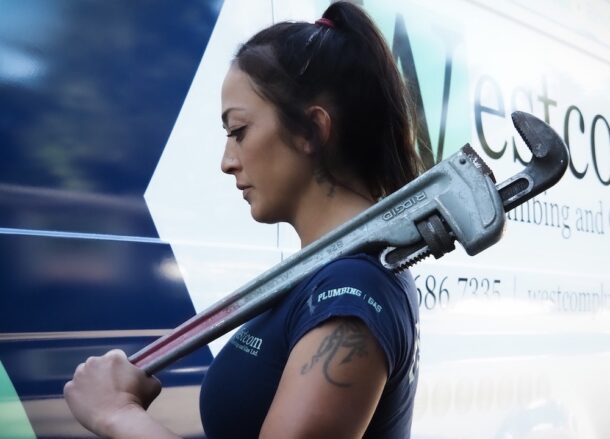
Bowcott eventually, through more pestering, landed a plumbing apprenticeship and never looked back after that. “Honestly though, it was hard making the transition, as again, no one took you seriously even though you were in the construction industry. Yes, I had made a name for myself, but only in the roofing community, so switching out was like starting all over again.”
 Now a 19-years veteran of the construction industry, a shingle roofer, Red Seal journeyman Plumber, Class B gas fitter and successful, award winning plumbing and gas business owner, “I hope that I can help pave the way for young women seeking a career in the building trades, showing first hand that you can do whatever you set your mind to with a little persistence, motivation, determination and a whole lot of pestering.”
Now a 19-years veteran of the construction industry, a shingle roofer, Red Seal journeyman Plumber, Class B gas fitter and successful, award winning plumbing and gas business owner, “I hope that I can help pave the way for young women seeking a career in the building trades, showing first hand that you can do whatever you set your mind to with a little persistence, motivation, determination and a whole lot of pestering.”
It shouldn’t go without noting that Bowcott often times censors her career path story, leaving out the dropping out of high school and getting into trouble. She is not ashamed or shy about how she got into construction. “I just don’t want high school students to drop out because they see someone who did, and then become successful. On the other side, I’ve also done public speaking on the fact that one can hit rock bottom, be mixed up in addiction and bad situations and still come out on top,” says Bowcott.
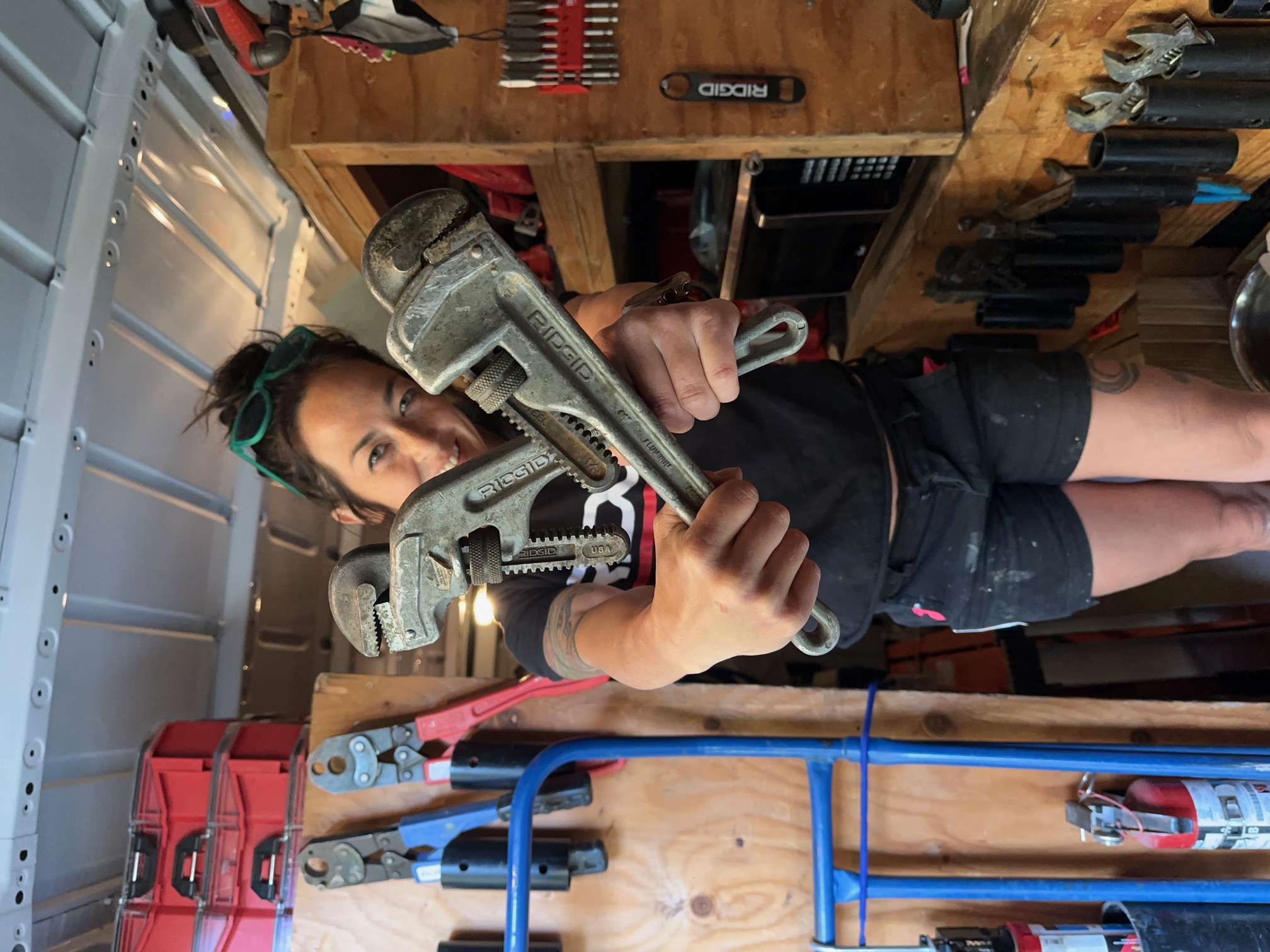 Fast-forward to 2023 and for the past eight years, Bowcott has been the proud owner of Westcom Plumbing and Gas Ltd, as well as Westcom Roofing and Sheetmetal, on Vancouver Island, British Columbia, Canada. The plumbing company specializes in plumbing repairs, service, drain cleaning, renovations, gas service, repairs, retrofit and light commercial.
Fast-forward to 2023 and for the past eight years, Bowcott has been the proud owner of Westcom Plumbing and Gas Ltd, as well as Westcom Roofing and Sheetmetal, on Vancouver Island, British Columbia, Canada. The plumbing company specializes in plumbing repairs, service, drain cleaning, renovations, gas service, repairs, retrofit and light commercial.
She finds the work particularly rewarding. “I really enjoy working with my hands and feeling like I’ve achieved something, helped someone, or made some sort of difference,” says Bowcott.
She always has been crafty, and coming from an artistic family, creating things has been something she’s done since she was a child. With plumbing and gas though—roofing as well—we are out there helping people, and she loves that. “Yes, the money is good, but it was never about that for me. It’s always been about helping and creating.”
Starting A Business
She knew she was ready to start her own company when she injured her back and almost went back to school to do hair. “But I couldn’t fathom going from my journeyman wage to minimum wage, especially with a mortgage,” says Bowcott.
“My husband and group of women I knew suggested why not start my own company? That way I could pick and choose the jobs I could do with the injury. I was at that time a new construction plumber and it wasn’t uncommon to do a full 7-10 days of straight groundworks. So, I quit my job and opened up my own company, and it was the best decision I have ever made.”
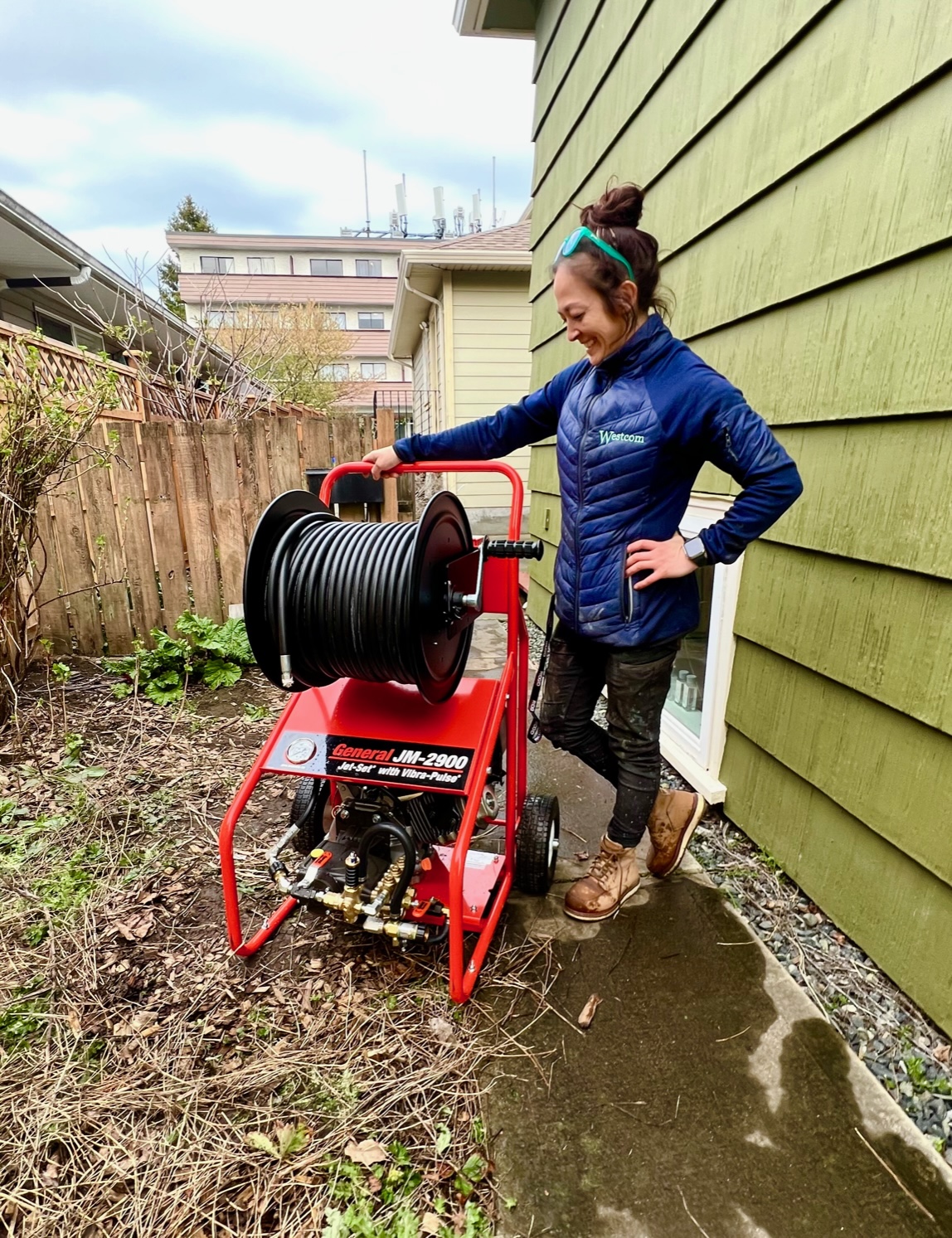 Nevertheless, as a woman-owned company in a male-dominated industry, Bowcott did have some anxious times, worried about work coming in. “I actually didn’t even put my name on my business card in fear that people wouldn’t hire me because I was a woman. I was wrong of course.
Nevertheless, as a woman-owned company in a male-dominated industry, Bowcott did have some anxious times, worried about work coming in. “I actually didn’t even put my name on my business card in fear that people wouldn’t hire me because I was a woman. I was wrong of course.
“There are people that don’t hire us because we are women, but we wouldn’t work for them anyway with that attitude. I kept the name of the business neutral as well to hide the woman factor. But honestly, I’m from a small town where everyone already knew me from growing up there, and as soon as I opened the company, like I mean day 1, I’ve been slammed busy. I didn’t advertise. I still don’t advertise. It’s all been word of mouth.”
Talking about being a female in this industry, Bowcott says she definitely tries her best to be a mentor for as many women as possible. Or men if they want, “but we don’t really get those calls lol.”
“I used to be more involved with non-profits and local groups, but I took a step back—as it was getting super time consuming and a lot volunteer work—to focus more on my business as well as social media as I seem to reach more women on social media than I did before.”
The Social Connection
 And because of social media, many doors have opened, more than Bowcott thought imaginable. “Being able to go to the RIDGID Experience 2022, going to conventions and trade shows and hanging out and becoming friends with the plumbers that you have followed for years, the supportive messages and the messages of people needing mentoring or advice, or simply messaging to say that I made a difference in their life as an inspiration to them is truly heartwarming,” says Bowcott.
And because of social media, many doors have opened, more than Bowcott thought imaginable. “Being able to go to the RIDGID Experience 2022, going to conventions and trade shows and hanging out and becoming friends with the plumbers that you have followed for years, the supportive messages and the messages of people needing mentoring or advice, or simply messaging to say that I made a difference in their life as an inspiration to them is truly heartwarming,” says Bowcott.
 “I am so grateful for the opportunities that have been dropped at my doorstep for simply taking a video or picture of what I did that day. And not that I needed to advertise, but I know a lot of my clients have called because of what they have seen on social media. They get to see what type of work you’re putting out there which really helps.”
“I am so grateful for the opportunities that have been dropped at my doorstep for simply taking a video or picture of what I did that day. And not that I needed to advertise, but I know a lot of my clients have called because of what they have seen on social media. They get to see what type of work you’re putting out there which really helps.”
Personal Touch
As far as downtime, what does Mary-Anne like to do to decompress? ““I don’t decompress haha. I rock climb, do Crossfit, personal training, surf, park roller skating, and I also clean my van at any opportunity if there’s something out of place. I try and do as much as possible at home before its time to make dinner. My days are long and exhausting, I can’t sit still, I don’t relax, I’m always on the go, and I wouldn’t have it any other way.”
 As well as hurting her back, she struggled with severe knee pain from, you guessed it, roofing and plumbing, and she actually thought she was going to need a knee replacement by 40. She met with a local athletic therapist and he said that if she didn’t do some sort of weight training to strengthen areas that needed it, her body would “implode by 40.” “S“So, I started at my local Crossfit gym, and shockingly after 2-3 months, I had zero knee and back pain. So, I am a believer. I now work out around 4-5 days a week depending on how busy I am.”
As well as hurting her back, she struggled with severe knee pain from, you guessed it, roofing and plumbing, and she actually thought she was going to need a knee replacement by 40. She met with a local athletic therapist and he said that if she didn’t do some sort of weight training to strengthen areas that needed it, her body would “implode by 40.” “S“So, I started at my local Crossfit gym, and shockingly after 2-3 months, I had zero knee and back pain. So, I am a believer. I now work out around 4-5 days a week depending on how busy I am.”
Though she already travels a lot, there’s a few items pending on her bucket list: going to Morocco, going to Turkey, skydiving, an Indonesian boating/surf trip, and a trip to Tahiti.
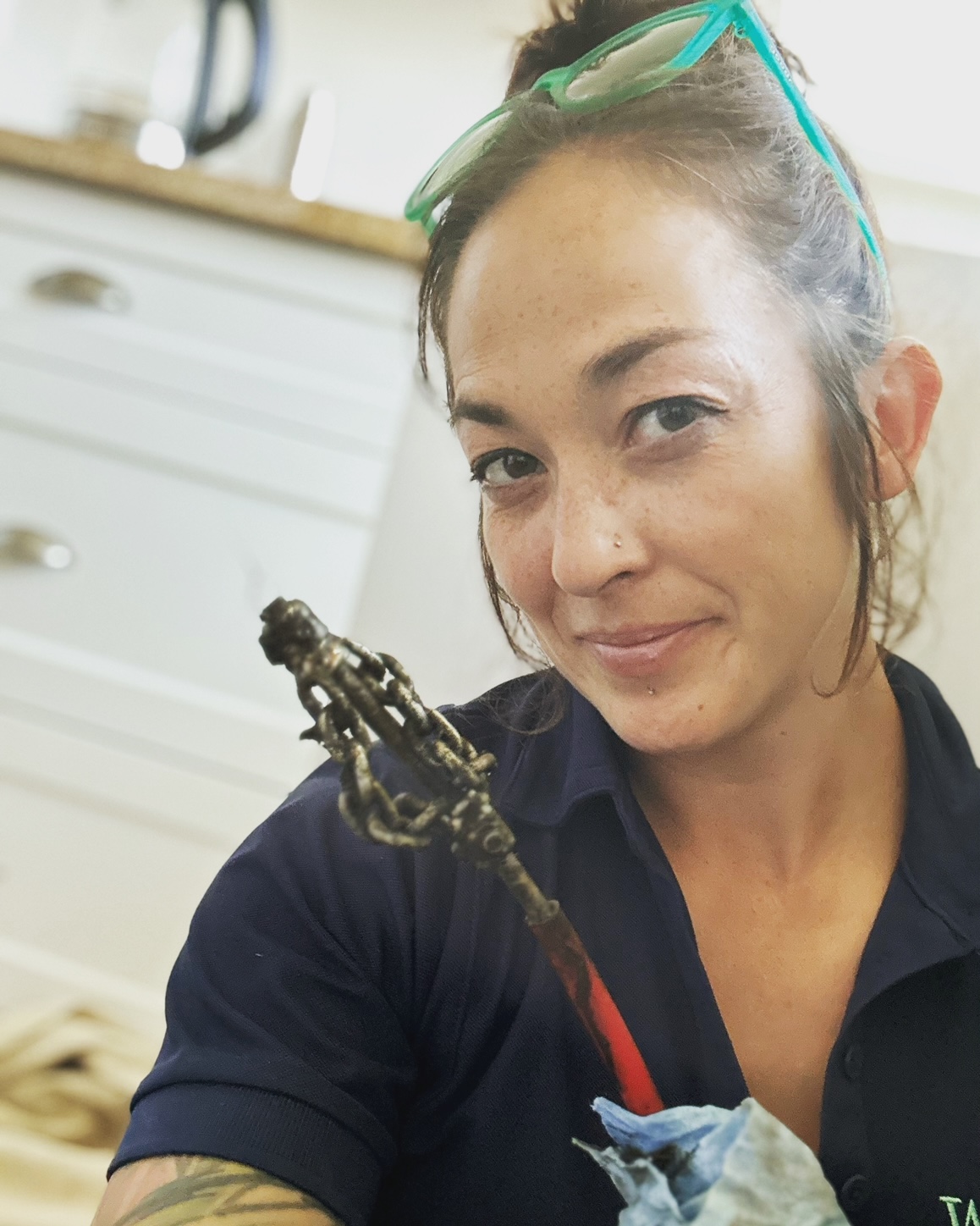 If you ask Bowcott about her tattoos, she’ll tell you she made a lot of poor tattoo choices in her younger days. “My first was a tattoo in a hotel room when I was 16 by a pretty dodgy character. Thank God I didn’t end up with a disease after that one. It was supposed to be a fairy, but ended up looking like a gremlin trying to bang itself with its foot. I got it covered up with a tiger on a waterfall landscape, but I hated that too as it was definitely too cartoonish. I ended up getting 12 laser treatments on it and finally found someone to cover it up, and that’s when I got the tiger on my back, which I’m super happy with.”
If you ask Bowcott about her tattoos, she’ll tell you she made a lot of poor tattoo choices in her younger days. “My first was a tattoo in a hotel room when I was 16 by a pretty dodgy character. Thank God I didn’t end up with a disease after that one. It was supposed to be a fairy, but ended up looking like a gremlin trying to bang itself with its foot. I got it covered up with a tiger on a waterfall landscape, but I hated that too as it was definitely too cartoonish. I ended up getting 12 laser treatments on it and finally found someone to cover it up, and that’s when I got the tiger on my back, which I’m super happy with.”
What’s next? Bowcott tries to live her life as each one is her last and she tries to experience as much as possible, “because you really don’t know when you’re gonna go and I want to make sure I do as much as I can before that day. My husband’s best friend passed away a few years ago at 50 and it really buggered me up. Ever since then, my life has been nothing but trying to do it all NOW!”
In the Tool Bag
RIDGID end 190” wrenches, adjustable wide mouth Crescent, RIDGID 154 quick acting tubing cutter, Stanley tape measure, Milwaukee flip knife, a Himor HVAC multi-tool, and a hacksaw.
In the Van
Milwaukee portable band saw, Milwaukee oscillating tool, Milwaukee Hackzall, grinder and Fuel Packout vacuum, and a Hilti jackhammer.

Our good friend Mike Prencavage Jr., owner of The Family Plumber, Los Alamitos, Calif., and president of PHCC CA-ORSB, and some of his California PHCC constituents, recently took a tour of SoCalGas’s [H2] Innovation Experience and new model net zero home. “We were fortunate to visit the SoCalGas facility in Downey, Calif., more specifically a Read more
Our good friend Mike Prencavage Jr., owner of The Family Plumber, Los Alamitos, Calif., and president of PHCC CA-ORSB, and some of his California PHCC constituents, recently took a tour of SoCalGas’s [H2] Innovation Experience and new model net zero home.
![sustainability, hydrogen fuel technology, renewable energy, SoCalGas’s [H2] Innovation Experience, SoCalGas, heating, cooling, HVAC, plumbing](https://mechanical-hub.com/wp-content/uploads/2023/08/PHCC-Socal-Tour-78-610x407.jpg)
“We were fortunate to visit the SoCalGas facility in Downey, Calif., more specifically a mockup home that runs off a mix of hydrogen and natural gas. The system is a H2 microgrid; it’s a regenerative system that can operate solely based off a small amount of water input from either a city source or from a desalinized source, or ocean water,” says Prencavage Jr.
![sustainability, hydrogen fuel technology, renewable energy, SoCalGas’s [H2] Innovation Experience, SoCalGas, heating, cooling, HVAC, plumbing](https://mechanical-hub.com/wp-content/uploads/2023/08/PHCC-Socal-Tour-7-610x407.jpg)
The Innovation Experience is North America’s first-ever clean hydrogen powered microgrid and home. This project demonstrates how carbon-free gas made from renewable electricity can be used in pure form or as a blend to fuel energy systems and communities of the future.
Part of the Experience features clean hydrogen production and storage along with a nearly 2,000 square-foot home that can draw power from solar panels and convert excess renewable energy into clean hydrogen. “Simply put, the net zero home is using solar energy through PV panels, which is then stored in batteries—that’s for the electricity to actually power the home. Then, through an electrolysis method, running the electricity from the battery through water, they are creating hydrogen, which gets stored in a tank which then gets used to mix with the natural gas in the home so that it reduces your natural gas intake from the city by 20 percent,” says Prencavage Jr.
![sustainability, hydrogen fuel technology, renewable energy, SoCalGas’s [H2] Innovation Experience, SoCalGas, heating, cooling, HVAC, plumbing](https://mechanical-hub.com/wp-content/uploads/2023/08/PHCC-Socal-Tour-18-610x407.jpg)
SoCalGas has made a considerable, multi-million-dollar investment in what they believe is the future of clean renewable energy. “It is truly amazing how technology has gotten to this point for renewables. As the argument has always been we’re switching to electricity—here is California, it has been a huge push—most Californians understand, we just don’t have the infrastructure for this … so this visit opened a lot of minds to an alternative-type fuel source when it comes to a blended mix of hydrogen and natural gas,” says Prencavage Jr.
Listen to more on the SoCalGas visit by listening to the Appetite for Construction podcast here:

Ever thought about changing trades? How about completely changing the industry or trade altogether? This week the guys take some messages from listeners asking advice about switching careers. Episode 200, hosted by Eric Aune & Andy Mickelson Send us your feedback or topic ideas over on our social channels! Eric Aune https://bit.ly/mechanicalhubIG Andy Mickelson https://bit.ly/AndyMickelsonIG Read more
Ever thought about changing trades?
How about completely changing the industry or trade altogether?
This week the guys take some messages from listeners asking advice about switching careers.
Episode 200, hosted by Eric Aune & Andy Mickelson Send us your feedback or topic ideas over on our social channels!
Eric Aune https://bit.ly/mechanicalhubIG
Andy Mickelson https://bit.ly/AndyMickelsonIG
Two master plumbers talk small business and skilled trades as hosts of the Make Trades Great Again podcast. Episode 200: Changing Trades
